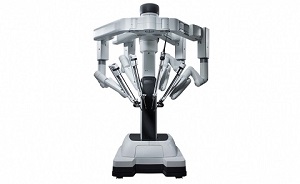About the Robot
Perhaps your doctor told you that a robotic procedure is available for your condition. You may be wondering how the robot works and what the procedure will be like.
Remember that a “robotic procedure” does not mean a robot is performing your surgery. Your experienced surgeon is in control the entire time. The robot’s design enables precision and wrist movements impossible for human hands.
Robotic Surgery: Experience and Expertise at St. Joseph’s Hospitals
At St. Joseph’s Hospitals Advanced Center for Robotic Surgery, your medical team will walk you through the procedure and answer any questions you may have. Our robotic surgeons are highly experienced in performing even the most delicate procedures. They receive extensive training in using the robotic surgical system, and they have performed thousands of robotic surgeries since the inception of the program.
Learn more about our robotic surgery specialties.
 Robotic Surgery: The Equipment
Robotic Surgery: The Equipment
Our surgeons use the da Vinci® Surgical System, the most sophisticated surgical system available. The equipment used for robotic surgery is designed especially to make your surgery as precise as possible. Equipment you will see in the operating room:
- Patient cart with four interactive robotic arms. These arms are what your surgeon will use to control the procedure. The robotic arms hold the surgical instruments and a high-definition camera. Your surgeon will make small incisions and insert the instruments and camera into the operating site.
- Surgeon’s console. This is where your surgeon sits and directs the surgery. The console is in the same room as the operating table, but located a few feet away. The console contains a screen, which shows the high-resolution, 3-D images of the operating site. Though your surgeon is not standing over you, he or she can see the operating site even better at the console, due to the high-quality images.
- EndoWrist® instruments. Your surgeon operates the instruments by using his or her hands and fingers. When your surgeon moves, the instruments inside you respond precisely to those movements, in real-time. EndoWrist instruments work like a human arm, with elbow and wrist-like movements, but they have a greater range of motion than the human wrist.
The da Vinci Surgical System provides an alternative to both traditional open surgery and conventional minimally invasive surgery. During a robotic procedure, your surgeon is at the controls of a state-of-the-art robotic platform. The robotic surgery system enables surgeons to perform even the most complex and delicate procedures with unmatched precision through very small incisions. See Why Robotic Surgery?
The newest da Vinci Xi Robot is one of our newest robotic machines at St. Joseph’s Hospitals. The da Vinci Xi benefits our patients with the advantages of minimally invasive surgery. The Xi robot has new visual enhancements like infrared imaging and is designed to facilitate anatomical access from any position with an even greater range of motion than ever before.
The Robotic Surgery Procedure: What Should I Expect?
In many ways, robotic surgery is similar to a regular procedure. You will receive anesthesia and be asleep for the entire procedure. Your surgeon will perform the operation and stitch up the incision at the end. However, there are certain key differences.
While each robotic surgery is unique, depending on your procedure, here is a general guide to what you can expect.
- The anesthesiologist and nurse anesthetist will place you under anesthesia.
- The surgeon will make a few small incisions into your body.
- The surgeon will insert the robotic instruments and high-definition camera into the incisions.
- The surgeon then returns to the console to perform the surgery. The camera provides an enhanced view of the operating site.
- A team of a first assistant and surgical technician will be near you during the entire surgery.
- The surgeon will operate by manipulating the EndoWrist controls. The instruments inside you respond precisely to your surgeon’s hand movements.
- Your surgeon removes the instruments and camera and sutures the incisions.
Robotic Surgery vs. Laparoscopic Surgery
Robotic surgery and laparoscopic surgery are both types of minimally invasive surgery. The goal of any minimally invasive surgery is to use smaller incisions or existing entryways into the body, resulting in less pain, less blood loss and a shorter recovery time.
Both robotic and laparoscopic procedures use miniature instruments that your doctor inserts into the incisions. So what does robotic surgery offer that laparoscopic does not?
Benefits of a robotic procedure versus a laparoscopic procedure:
- Superior dexterity. Robotic instruments give your surgeon greater agility, since they have more flexibility than a human hand.
- Enhanced visualization. The screen at the console shows a magnified image of the operating site, giving your surgeon a clearer 3-D picture.
- Better access. Your surgeon has incomparable access, even to hard-to-reach places, since the robot can access areas that traditional laparoscopic instruments cannot.
Keep in mind that your surgeon has your best outcomes in mind. Sometimes, he or she may feel that a laparoscopic or traditional surgery is the best approach for you. Our surgeons are experienced in performing all types of surgery. We will choose the procedure that has the greatest benefit for you.
